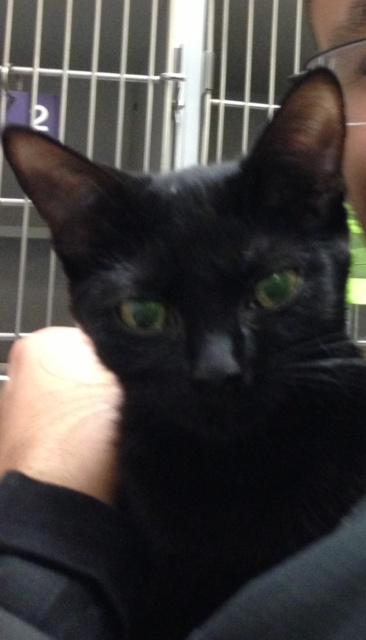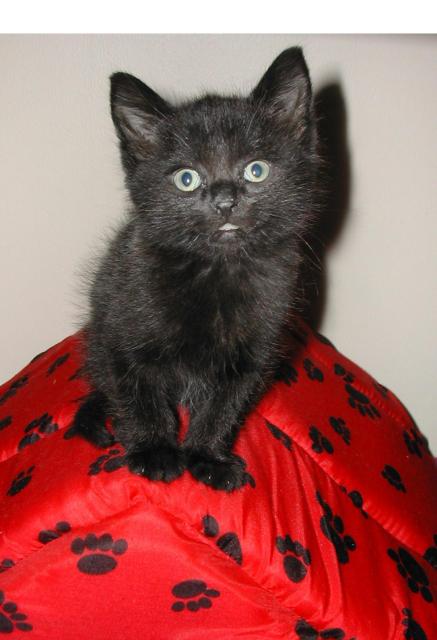QuestionI have a pure breed ragdoll kitten and have had her for 6 weeks and she will not come out from hiding, runs away from us as soon as we are near her or even runs when we look at her. we just want to love her but we go days with out seeing her. she just does not like us, we have never hurt her we just want to cuddle her and play with her, I just do not gert what we are doing wrong and do not no how to fix it. please help as I am very upset about this.
AnswerHello Michelle,
I'm sorry to hear you are having this distressing problem, but with some help to understand why this is happening and lots of patients while you attempt some modification techniques you and your kitten have a good chance of overcoming this.
(The methods I describe below should be carried out by just one of you, the person she seems a little less threatened of, women are usually better as they generally have slower movement and softer voices)
Kittens have what is known as a 'sensitive period of socialisation' in their development. This generally takes place during 2-7 weeks of age. During this time the owner (usually breeder in the case of pedigree cats) must introduce the kitten to as many stimuli as possible for example, people, other animals, children, vacum cleaners! This is important in enabling the kitten to cope in interaction with their environment and be taught to accept that all the signs of human activity are normal and not things to be scared of. If this has not taken place sufficiently during this period then the kitten is more likely to be fearful of people and everything we do in our normal lives. Many of us now also believe genetic factors can play a part in the 'boldness' or 'timidness' of the kitten also. It is always a good idea to choose a kitten from parents that are well socialised with people, bold and playful.
Introducing the kitten into your home should be done slowly and correctly, your home and yourself are unfamiliar to the kitten and this is going to be very stressful for her. This may have been done incorrectly as unfortunately the breeder may not have given you correct guidlines on how to do this.
Ok, so firstly provide a quite room in your house for her, one that you will not need to use very often so this can be her 'safe place', provide food, water, litter tray and toys in there for her. Buy a Feliway diffuser (you can purchase these from most pet shops and vet surgeries) and plug this into the room also, this will give her a sense of security and help her to relax. Do not leave the door to this room wide open but leave it ajar a little so that when she is ready she can take the first steps outside. Secondly do not try and directy approach her, look directly at her, make any loud or sudden movements or noises towards her, all of these things are threatning signals to cats and this will make her withdraw even more. When this is all in place the next step is to use 'desensitisation' methods.
Go into her room quietly and sit on the floor, making sure you are as far away as possible. Do not look at her, but talk very gently and quietly to her, repeat this a few times, she may or may not move closer to you, regardless to this you must still not look at her and continue to talk gently. When you have done this a few times you can then move a little closer, then after a few times in that spot, move a little closer and so on. You must make sure that if she shows fear towards you when you are at a certain point near to her then move back to the previous place and begin again. You may find that she will after a period come closer to you or you may find that you can get to a point where she will allow you sit next to her without showing fear.
When you have reached a point whereby you can sit quietly near to her without her showing fear towards you, you can then begin 'counter-conditioning' methods. This is very simple. The fact is when you are at the point whereby she can sit next to you and show no response, you then need to change her 'neutral' response to a 'pleasant' response. We can do this by using the cats favourite thing, this can be a food treat or a game. In this case a food treat might be a good start. What you need to do is, when she is at her 'comfortable' position near to you, drop a treat on the floor next to you, still do not look at her and wait for her to come and get it, this may take time but continue and be patient. Continue to do this often. She should then begin to associate you with a pleasant experience rather than a frightening or neutral one. At this point you should be able to approach her without eliciting a fear response.
Give her time, try and keep noisy activity to a minimum, do not try and introduce her to an array of people and stimuli while you are using this method. Allow this to be carried out between just you and her until you have built a better relationship, this is going to take time and patients but Im sure you can both do it.
I hope this general starting point has helped you a little and good luck.
Thank you
Kelly

 my kitty Valentine
QuestionQUESTION: my kitten is 3 month old I only had h
my kitty Valentine
QuestionQUESTION: my kitten is 3 month old I only had h
 Cats continuing to pee on bed(s)
Question
Our cats...Payten and
I have read the
Cats continuing to pee on bed(s)
Question
Our cats...Payten and
I have read the
 Ocicat
Question
Sesame
My daughter is currently living in Thai
Ocicat
Question
Sesame
My daughter is currently living in Thai
 Bombay at local pound??!
Question
Wide set eyes Kitten
Hi I have a
Bombay at local pound??!
Question
Wide set eyes Kitten
Hi I have a
 kittens nails
QuestionQUESTION: Hi Pati,
Its me again Xris. I seek y
kittens nails
QuestionQUESTION: Hi Pati,
Its me again Xris. I seek y